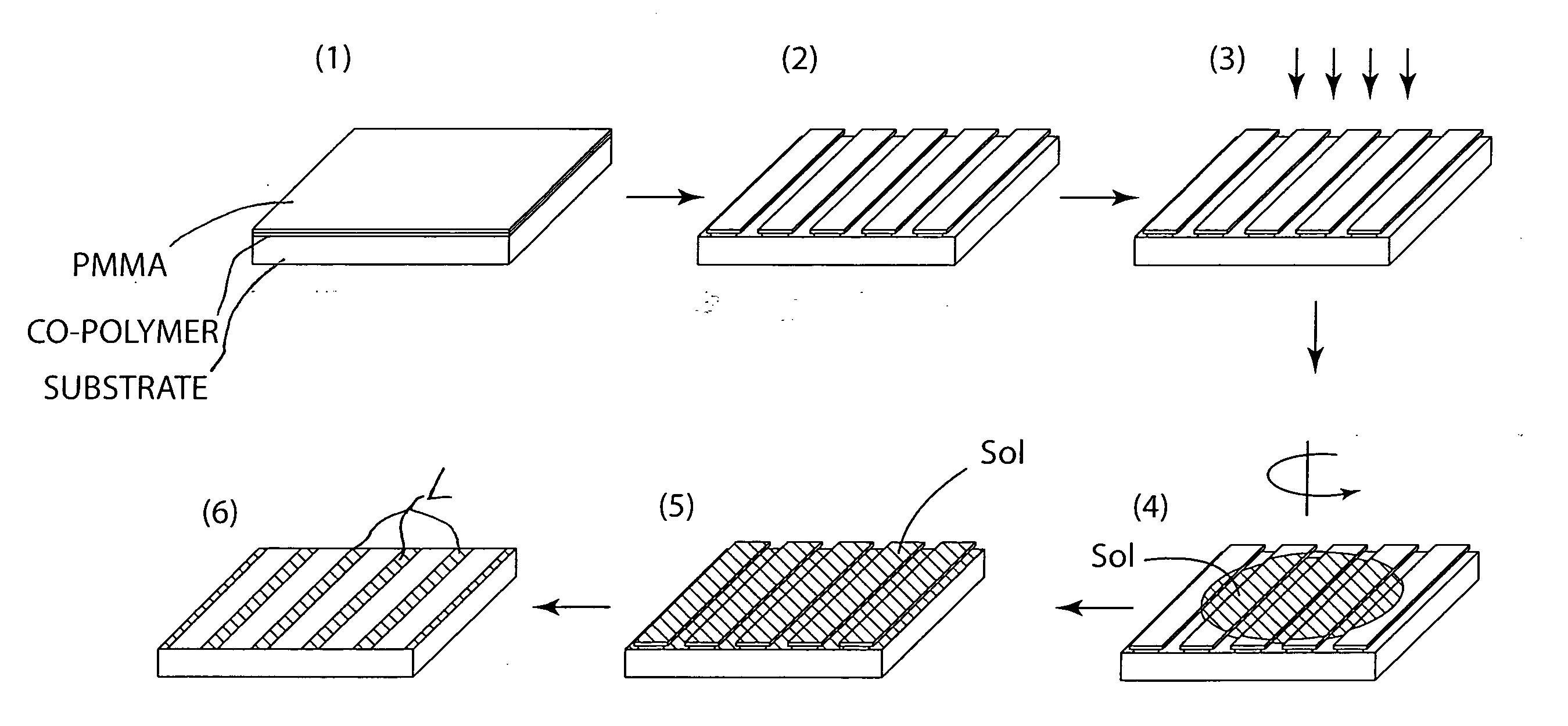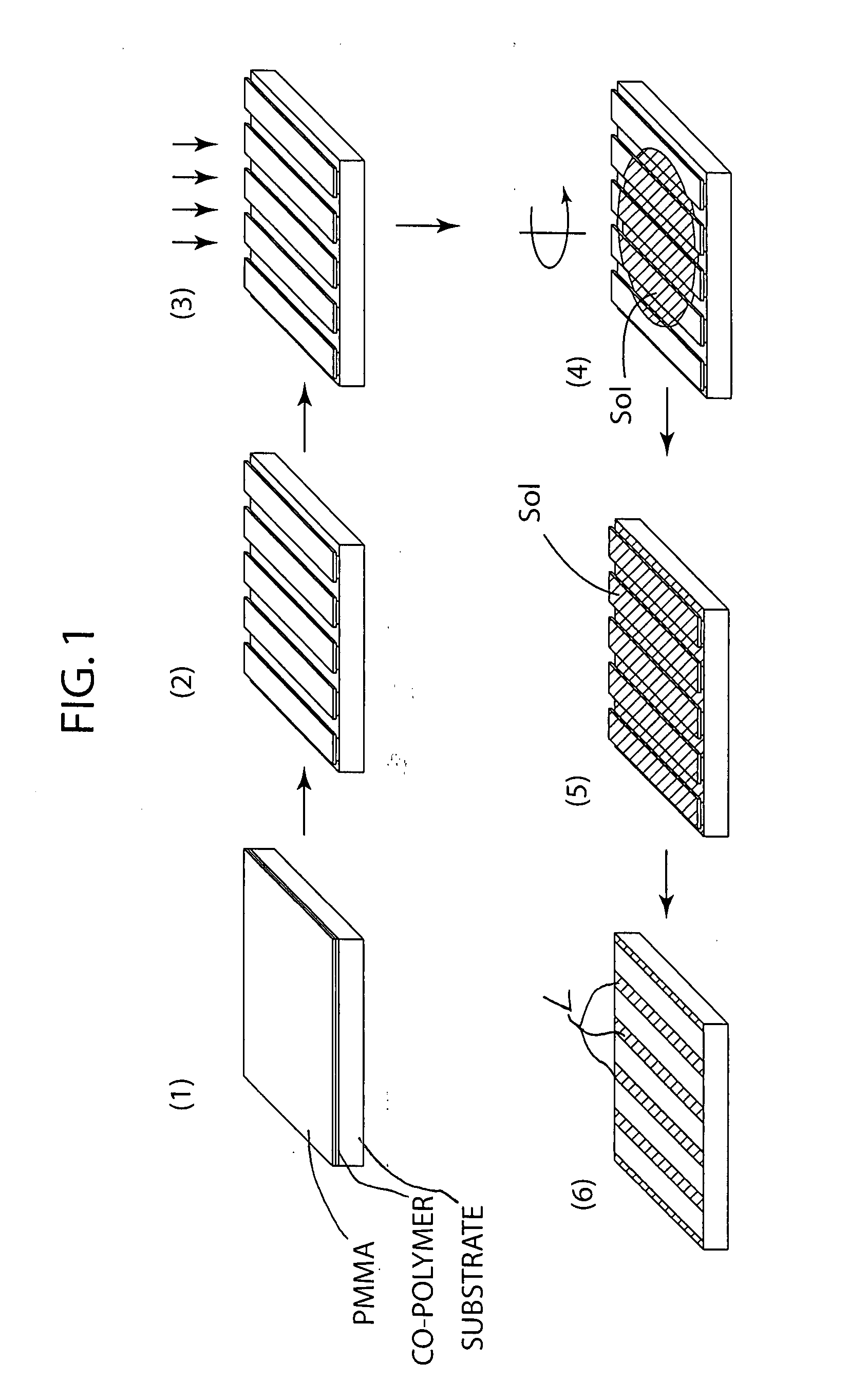Method of making nanopatterns and nanostructures and nanopatterned functional oxide materials
a functional oxide and nano-structure technology, applied in the field of making nano-structured functional oxide materials, can solve the problems of difficult etching of such materials, limited technique for ceramic patterns under 100 nm resolution, and inability to achieve true nanometer-scale patterning resolution. achieve the effect of higher patterning speed
- Summary
- Abstract
- Description
- Claims
- Application Information
AI Technical Summary
Benefits of technology
Problems solved by technology
Method used
Image
Examples
example 1
[0037] To demonstrate the capabilities of an illustrative method, liquid precursors of technologically important inorganic ceramic oxides ZnO and PZT were evaluated. The liquid ZnO precursor was prepared using chemicals purchased from Sigma-Aldrich Inc. and used in as-received form without further purification. In a typical process, zinc oxide sol is prepared by stirring a mixture of zinc acetate dihydrate, 2-methoxy ethanol, and ethanol amine at 60° C. for 2 hr. The relative compositions were adjusted to give a 0.1 M ZnO sol with equimolar ratio of zinc and ethanol amine. This sol is transparent and remains stable for more than a year.
[0038] Referring to FIG. 1, illustrative steps in nanopatterning pursuant to a method embodiment of the invention are shown schematically. The first step (1) is to sequentially spin-coat a surface-oxidized Si substrate (Siox / Si) with a bilayer structure of electron beam (eb) sensitive resists with a relatively higher eb sensitive MMA-MAA copolymer re...
example 2
[0043] This example is provided to illustrate that an organic material can be patterned using a dilute solution of polypyrrole, a popular conducting polymer, on a SiOx / Si substrate surface. Polypyrrole in 3% water was received as a black solution with proprietary organic acids from Sigma-Aldrich Inc. This solution was further diluted to a 1:3 ratio of polypyrrole to water and was used for patterning polypyrrole patterns with different line widths and spacing, FIG. 3. The method steps were the same as those described with respect to EXAMPLE 1.
example 3
[0044] This example demonstrates that the above method embodiment can be practiced to nanopattern diverse material systems with a variety of substrates. For example, FIG. 4a shows a PZT ring structure having a wall thickness of 80 nm patterned on a Pt / Ti / SiOx / Si substrate using the method of FIG. 1 with a transparent and highly stable 0.1 M PZT sol. FIG. 4b shows 500-nm-wide PZT square patterns on a Nb doped strontium titanate (Nb / STO) single-crystal substrate. FIG. 4c shows a ZnO spiral pattern on a sapphire substrate.
[0045] The 0.1 M PZT sol was prepared using lead acetate and titanium isopropoxide and zirconium-n-butoxide as respective metal precurosrs. These precursors were mixed with a 1:1 volume mixture of acedic acid and 2-methoxyethanol. The entire solution was heated at 70 degrees C. while continuously stirring for 2 hours.
[0046] The patterns in FIGS. 4a and 4b were annealed at 600 for 2 hr in air. The height difference at the edges of the square patterns in FIG. 4b is a ...
PUM
| Property | Measurement | Unit |
|---|---|---|
| diameters | aaaaa | aaaaa |
| diameters | aaaaa | aaaaa |
| diameters | aaaaa | aaaaa |
Abstract
Description
Claims
Application Information
 Login to View More
Login to View More - R&D
- Intellectual Property
- Life Sciences
- Materials
- Tech Scout
- Unparalleled Data Quality
- Higher Quality Content
- 60% Fewer Hallucinations
Browse by: Latest US Patents, China's latest patents, Technical Efficacy Thesaurus, Application Domain, Technology Topic, Popular Technical Reports.
© 2025 PatSnap. All rights reserved.Legal|Privacy policy|Modern Slavery Act Transparency Statement|Sitemap|About US| Contact US: help@patsnap.com



